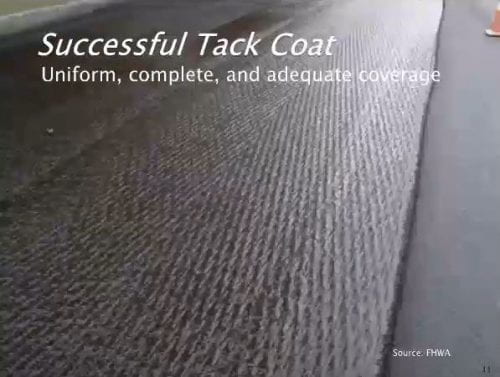As you have seen in past articles, the Pavement Preservation & Recycling Alliance (PPRA) Treatment Toolbox is available as a free, online resource for your pavement preservation planning and yet another great tool in their Treatment Resource Center is a deep-dive on tack coats for pavements.
When there is good bonding between layers in an asphalt road, the cross section acts more like a single system, providing much greater structural stability and long-term durability. As a result, tack applied between layers, as well as to curb edges and manholes, is often known as a bond coat. If you prefer to call it thousand island dressing, that’s fine, but what is important is that tack coat be applied consistently and correctly. Too often, tack is applied badly or not at all and that is the source of or contributor to several premature pavement distresses we regularly encounter. So, if you want to up your game with pavement life, understanding tack is a good place to start and the PPRA website is a good tool to use.
Once you have required tack as part of your paving project (e.g., DelDOT’s Standard Specifications for Road and Bridge Construction, Sections 401 and 1011), ensure that it is applied correctly after thorough surface preparation. Your specifications should require the contractor to clear the surface of oils and debris, regardless of whether the existing surface has been cold-milled or not. Tack should then be applied uniformly and cured before placing the mixture. Sometimes misunderstood or overlooked is the proper application range, depending upon the nature of the existing surface. DelDOT’s Table 401-B is a good example of surface types and application rates.
 There are quite a few types of tack emulsion. DelDOT specifies use of CSS-1, CSS-1h, or CRS-2P. The first two of these are slow setting emulsions and hence, rather forgiving. The last one, however, is rapid setting (starting to see the secret code?) and is modified with polymers.
There are quite a few types of tack emulsion. DelDOT specifies use of CSS-1, CSS-1h, or CRS-2P. The first two of these are slow setting emulsions and hence, rather forgiving. The last one, however, is rapid setting (starting to see the secret code?) and is modified with polymers.
Tacks are deceptively complex. From a distance, they are simple enough. A typical tack consists of a blend of three basic materials – mostly asphalt binder, a bunch of water, and a small amount of a surfactant (soap) or emulsifying agent. Emulsion is brown and turns black when it “breaks.” That’s it. Well, no it isn’t – there are chemists that are constantly poking at emulsion recipes and you can call them tack nerds if you want, but it’s because of them that we have better performing tacks and we understand better how to use them. So let’s do that – use them better, that is.
This “breaking” of emulsion often goes unexplained, so let’s demystify it. Now, it is probably enormously complicated, with all manner of chemical interactions, bonding, electromagnetic forces, and so on, but for our purposes, it is sufficient to know that the chemistry results in the water leaving the material and that’s when it turns from brown to black, because we are left with the residue, which is what we are after. Set aside what you were taught as a child, that oil and water don’t mix, because they will, under the right circumstances, and that’s pretty handy, because it allows us to deliver the asphaltic binder in a uniform manner exactly where we need it without nearly the mess and difficulty if we tried to do it without an emulsion. When the material breaks (you can say “abracadabra” if you like), the residue should be in the ranges seen in Table 401-B.
There are a number of ways to test and monitor the application rate of tack and the result should be an even application that is visually apparent. If the distributor truck creates “pencil lines,” if noticeable unevenness of the tack across the roadway is evident, or if pooling of tack occurs, the tack is incorrectly applied and the resulting asphalt job will be compromised from day one. Finally, all curbs, gutters, manholes, or other structure surfaces the mixture will contact should be tacked as well. Calibration of the distributor truck is an important component of even application, as discussed by PPRA.
PPRA estimates that tack represents approximately one percent of the cost of a pavement job, and yet some contractors still seek shortcuts, some owners fail to adequately specify tack in their contracts, and some inspectors are unwilling to hold the contractor to the requirements of the job. In all instances, the public suffers because their tax dollars purchase a less durable pavement.
The PPRA Resource Center is worth a little time to better understand tack, because so many pavements projects could benefit from better tack application. The Delaware T2/LTAP Center’s Municipal Engineering Circuit Rider is intended to provide technical assistance and training to local agencies and so if you have pavement management questions or other transportation issues, contact Matt Carter at matheu@udel.edu or (302) 831-7236.


You must be logged in to post a comment.